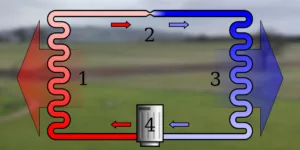A heat pump is a way to decrease your heating and cooling bills on the long run. Despite the fact that the initial heat pump installation cost is somewhat scary, you must treat it as an investment in the future, hat will benefit you as a considerable homeowner.
To understand the benefits and the installation process, it is best to let the professionals explain. Here is an intro to heat pump installation in the UK with Husky Air Source Heat Pumps LTD.
Here are some pros:
- Efficient running costs. Heat pumps will decrease your annual bill for heating and cooling for about 50% or around it. Thus, the installation expenses will be overcome in several years thanks to the considerable economy (a tip: installing a heat pump will be anyhow effective if your outdoor temperature does not drop below -4 °C in 95% of the time through a year).
- Less space to take. Compared to burners/air conditioners main modules, a heat pump occupies almost always less square area to be mounted.
- Increasing your house value. After installing a heat pump, in all years to come, your house value will increase compared to if not installed.
- Cleaner air. Because a heat pump does not move the air inside your dwelling from the outside, it’ll neither dry it nor pollute it. Furthermore, it has the built-in filter so it can even clean up the inside-premises air if it is polluted.
- Safer than any combustion unit. No further explanations – it is the way it is.
What does a heat pump installation cost?
Any HVAC system has its installation costs. The table below shows the average price and cost of labor together.

These do not take into account additional cost for a heat pump installation like ducts or pipes/radiators mounting. They may range from £2,250 to £13,600 for a single house (if to consider you don’t have any system at a moment). Although, it’s required if you install a ground-to-water, water-to-water or air-to-water heat pump. If your choice is air-to-air, no pipes will be demanded.
What affects the expenses:
- The necessity to drill through your foundation, walls, ceiling, under-floors
- How big your house is (and how many rooms do you want to connect to the system, whether it’ll be a single-room HVAC or for the entire house) affects the value
- Will it heat only air or water too, will it work for cooling and heating
- If it requires additional advancements of the heat pump to work under extreme temperatures (below -4 °C or over 27 °C (when used for cooling)).
The long-term win from having a heat pump is not only running costs but also some reimbursements received from the government.
Below, we’ll tell you about a brief process of installation of a heat pump with your own hands (if you are handy enough to do that). But beware: self-installation will make you be declined from the governmental reimbursement programs for ground, water, or air source heat pump installation.
Air source heat pump installation
We do not take into account such optional steps that may arise during installation as setting pipes, heat radiators, connecting a pump to a system of ‘warm floor’, and insulation.
- Take a set of tools: level, drill, pliers, hammer, hole saw, cable tie, wire stripper or a knife, and a tape. These are besides the condenser and a pipe itself.
- Install a condenser outside the house. Drill an opening in the wall to connect it with an indoor module.
- Install and mount air handler module on the wall and connect it to the condenser.
- Cover the lines and close all the openings to make your house look beautiful again.
- Make final connections and test the smooth work.
Now, as you know the basic steps, you can find more information or videos on the Internet how to make it on practice and you’ll save some thousands of pounds.








